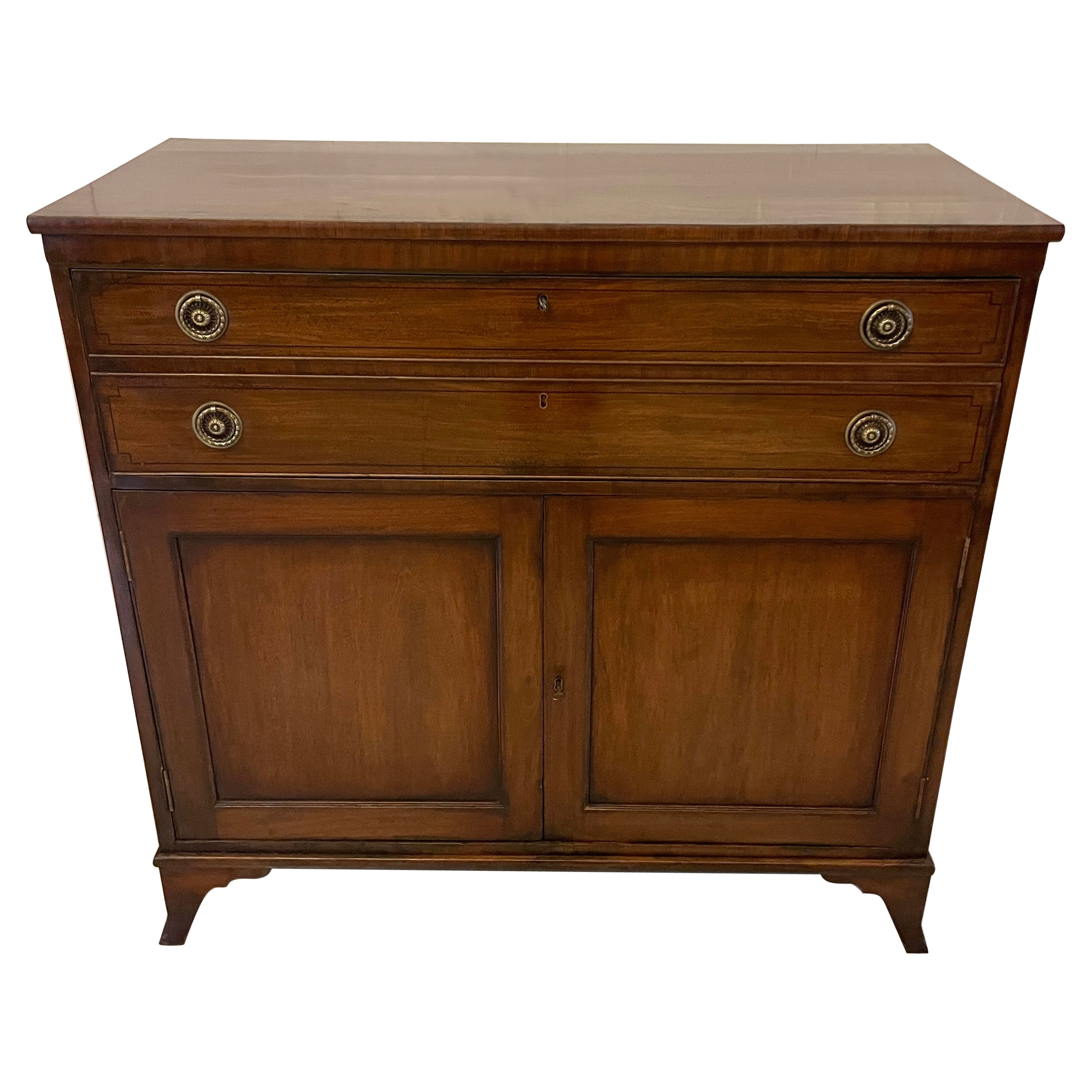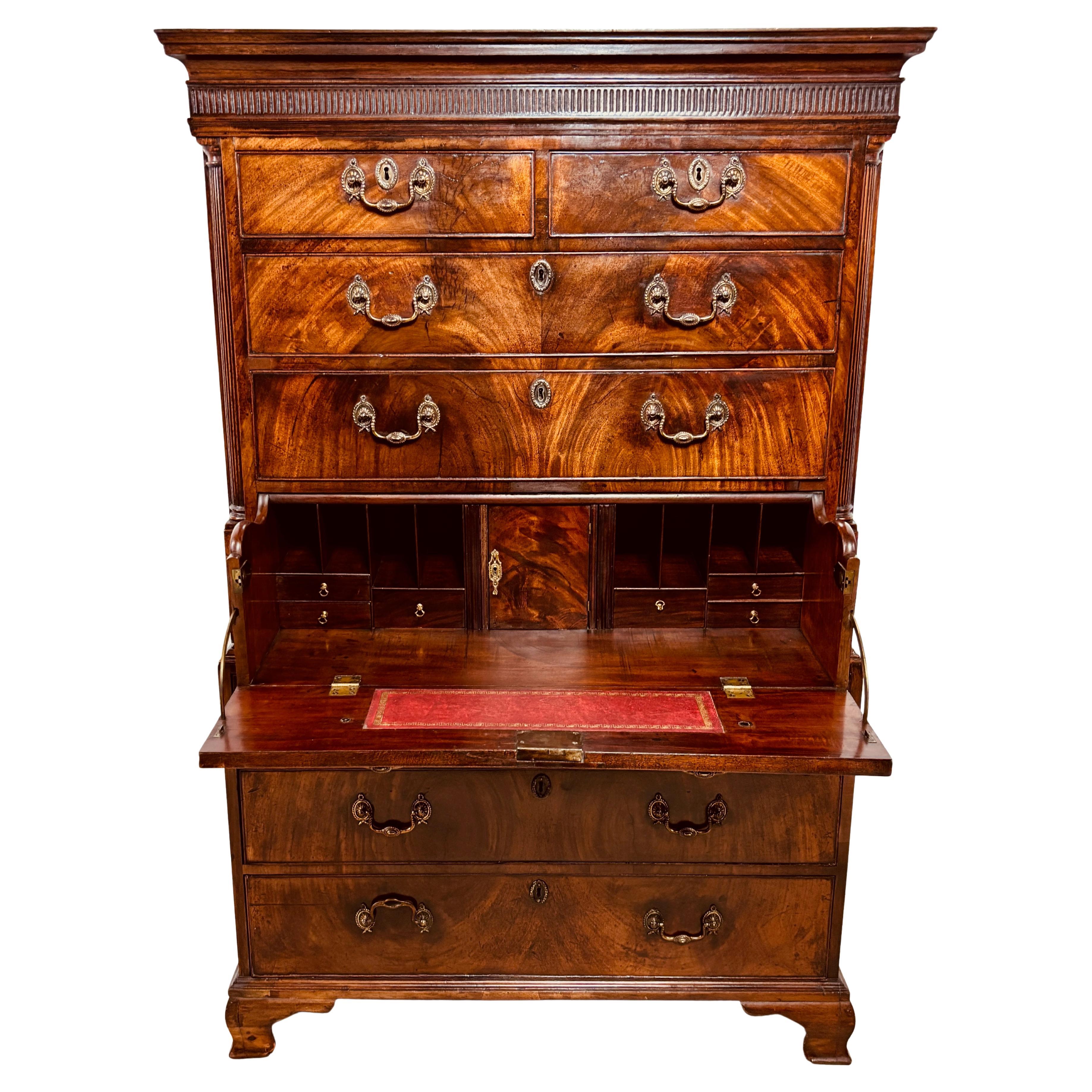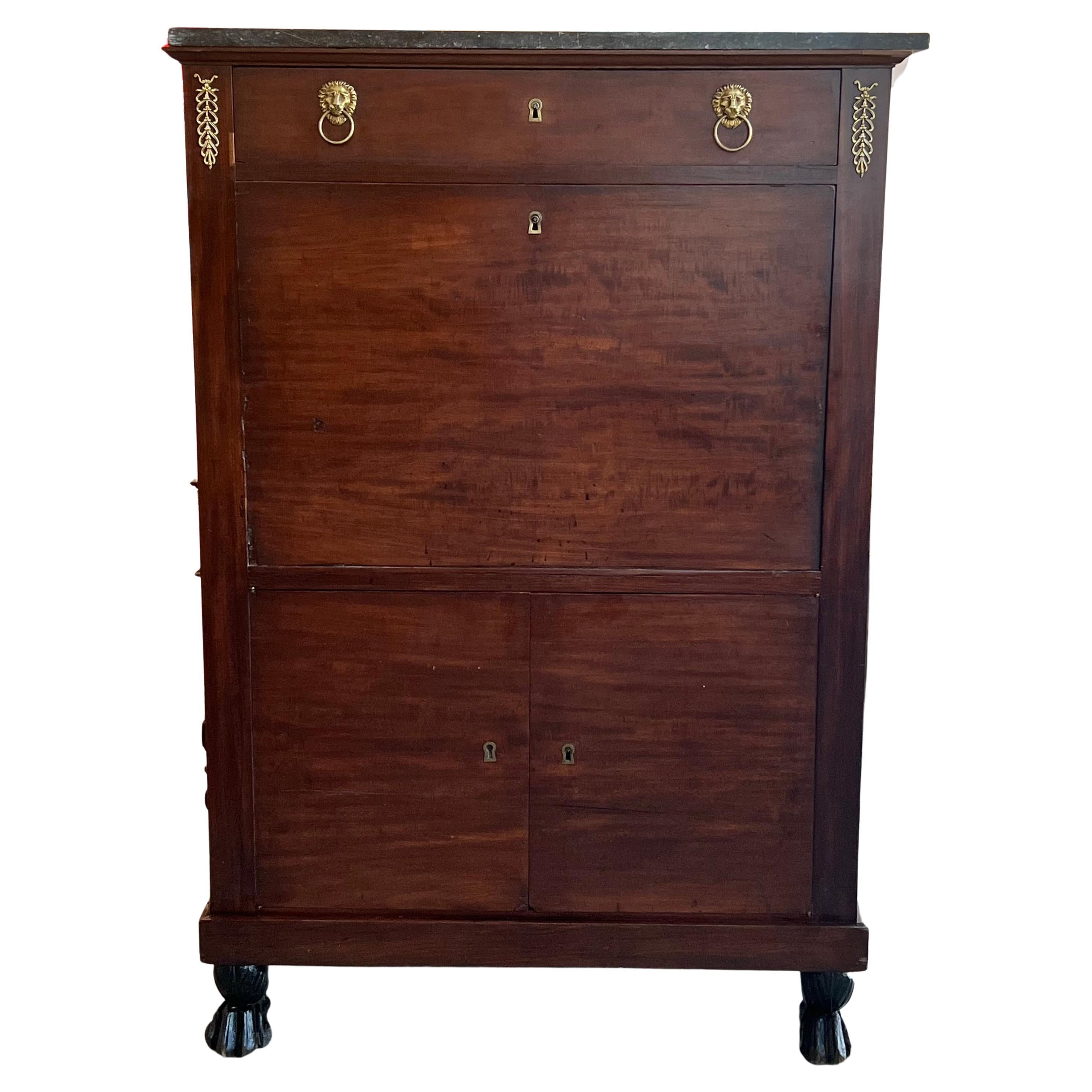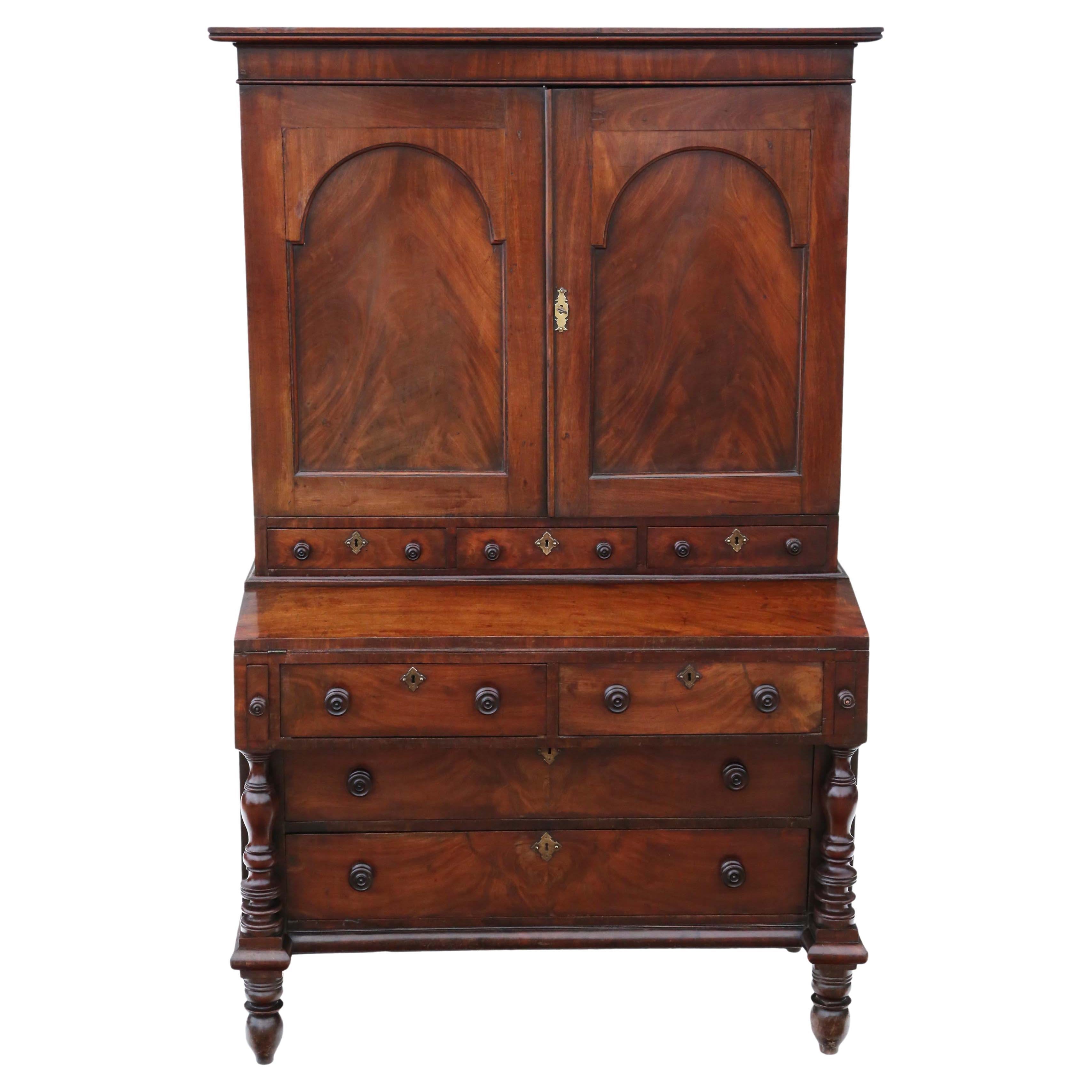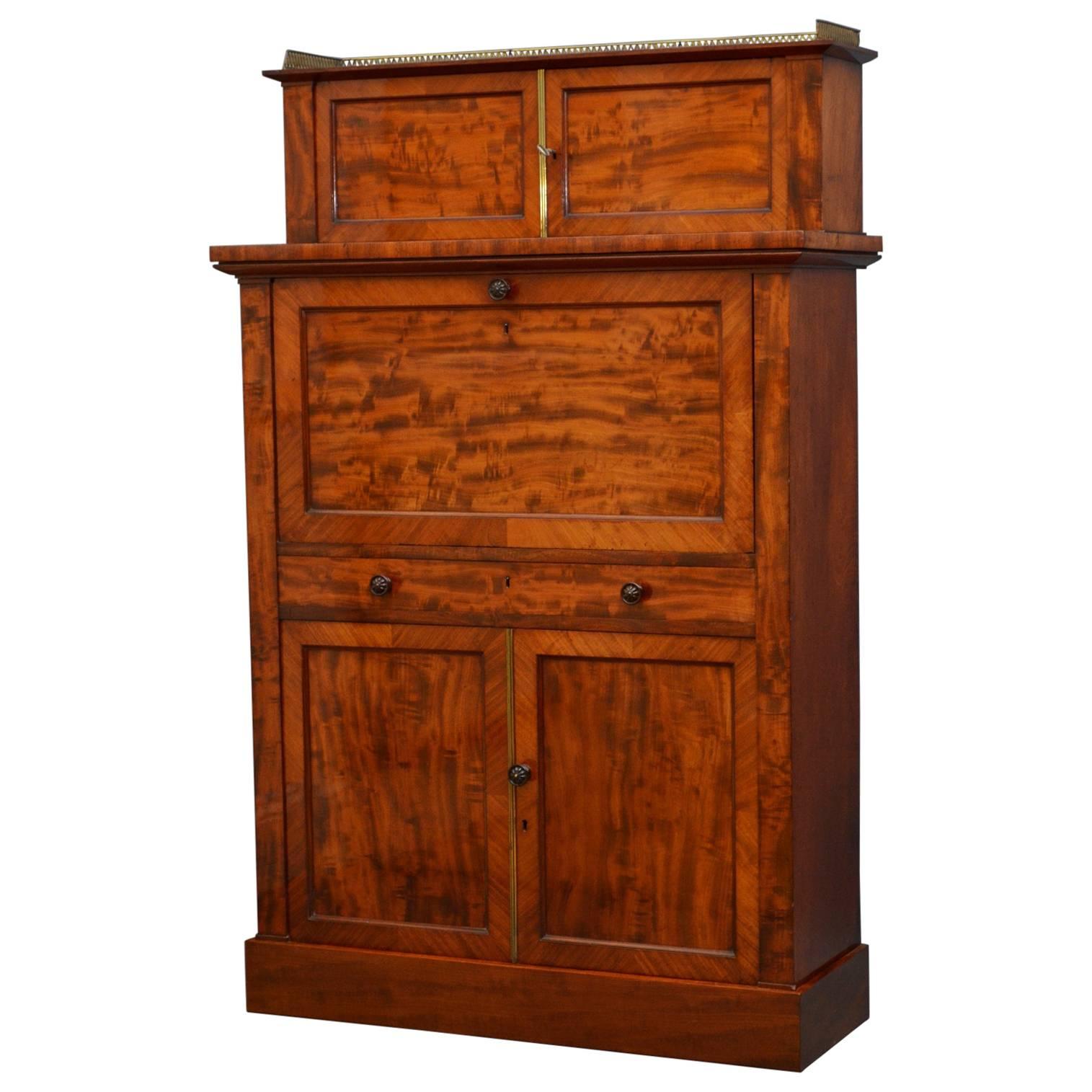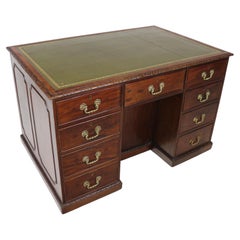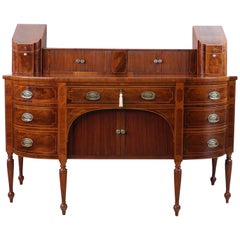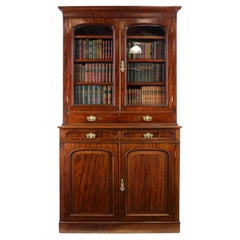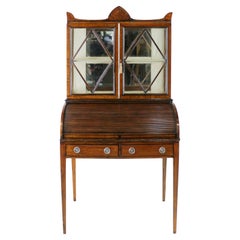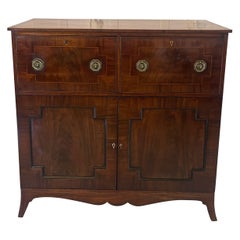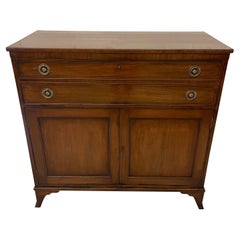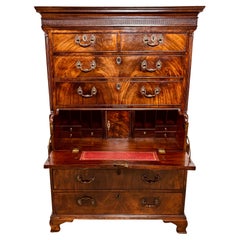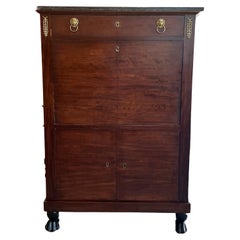Items Similar to Gillows Antique English George III Mahogany Secretaire Low Press Cupboard
Want more images or videos?
Request additional images or videos from the seller
1 of 21
Gillows Antique English George III Mahogany Secretaire Low Press Cupboard
$8,852.92
£6,460
€7,536.64
CA$12,126.28
A$13,487.07
CHF 7,042.53
MX$164,123.35
NOK 89,943.87
SEK 84,351.48
DKK 56,248.83
Shipping
Retrieving quote...The 1stDibs Promise:
Authenticity Guarantee,
Money-Back Guarantee,
24-Hour Cancellation
About the Item
circa 1790. With a rectangular top over a concealed long drawer with sloping front, mahogany crossbanding and parquetry and box stringing which continues across the top of the sides, the two long false drawer fronts below forming a deep secretaire drawer containing a writing slide with a hinged, ratcheted green baize inset slope above a central well flanked by six crossbanded and boxwood strung lidded and alphabetically ordered compartments, each inlaid with an oval panel engraved with four letters of the alphabet, and concealing secret recesses with drawers and original green fabric pulls.
The pair of flame mahogany crossbanded and rope twist inlaid panelled doors below opening to reveal three sliding trays and all raised on ogee shaped bracket feet with weight bearing blocks behind. Original brass swan neck handles, locks and door catches. Marks and chips consistent with age and regular use and some old restorations, including dark marks to the top surface and chips to the back edge, replacements to the cockbeading and some losses which we can replace, one tray a period replacement in oak.
Please feel free to request more photos as we are limited in the number we can upload.
The overall dimensions at the largest points are approximately
Width - 48 5/8in (123.5cm)
Depth - 24 1/4in (61.5cm)
Height - 41 7/8in (106.3cm)
Writing slide
43 3/8in wide x 21 3/4in deep x 34 1/2in high (110.2cm x 55.2cm x 87.7cm)
Ref: 0690
Gillows of Lancaster were a leading manufacturer of furniture during the 18th and 19th centuries established around 1730 by a cabinet maker named Robert Gillow (I) (1703-1772). Robert was known for his use of mahogany which he imported from the West Indies and within a few years his workshop was being recognised for its superior quality of construction and use of desirable mahogany becoming one of the largest furniture producers outside London. He established the firm’s first links with London and the gentry, and sent his eldest son Richard (1733-1811) to be apprenticed to a ‘Mr. Jones’ of London, probably the architect William Jones. The London Oxford Street shop was established in 1769-70, new workshops were built in both Lancaster and London and furniture ordered in London was sent every week from Lancaster. Importantly, from the mid-1750s, Richard, working in Lancaster, could draw fashionable new furniture based on designs sent to him by his cousin James, a journeyman in London. When Robert Gillow died in 1772, the business passed to his two sons, Richard and Robert. While Robert managed the London branch, and was thereby familiar with all the latest London fashions, Richard ran the Lancashire base. It was between 1750 and 1811 that some of the best English furniture ever was being produced by the Gillow company in Lancaster.
Architect’s desks and chests with a secretaire drawer appeared in the Gillows Estimate Sketch Books at the very end of the 18th and very beginning of the 19th centuries in various forms, including those with rising ratchetted tops. One notably refined recurring feature considered a hallmark of Gillows design is this secretaire with upper sliding writing slope and the lower half fitted with an arrangement of six hinged lidded compartments inlaid with an oval engraved with four letters of the alphabet. Secret or ‘private’ drawers, as Gillows called them, with green material pulls were concealed at the back of these compartments. The designs and drawings for secretaire library cabinets in the Gillows Archives include ‘Lettering the covers in the writing drawer’. Many cabinets, ‘buro’ writing tables, desks and bookcases from the 1780s and 1790s appear in the ledgers and numerous illustrated examples with a secretaire drawer includes the words about the alphabetically inlaid covers.
- Attributed to:Gillows of Lancaster & London (Cabinetmaker)
- Dimensions:Height: 41.86 in (106.3 cm)Width: 48.63 in (123.5 cm)Depth: 24.22 in (61.5 cm)
- Style:George III (Of the Period)
- Materials and Techniques:
- Place of Origin:
- Period:
- Date of Manufacture:Circa 1790
- Condition:Replacements made: One sliding tray replaced with another period oak tray. Repaired: Some cockbeading replaced & some losses, repair to top of drawer at lock, ,. Wear consistent with age and use. Minor losses. Original colour & finish, dark marks to top & interior, shrinkage lines to top & sides, appears to have had mouldings added and removed to the sides at some point, marks to bottom edge of drawer.
- Seller Location:Glasgow, GB
- Reference Number:Seller: 06901stDibs: LU2763330675282
About the Seller
5.0
Vetted Professional Seller
Every seller passes strict standards for authenticity and reliability
1stDibs seller since 2017
34 sales on 1stDibs
- ShippingRetrieving quote...Shipping from: Fife, United Kingdom
- Return Policy
Authenticity Guarantee
In the unlikely event there’s an issue with an item’s authenticity, contact us within 1 year for a full refund. DetailsMoney-Back Guarantee
If your item is not as described, is damaged in transit, or does not arrive, contact us within 7 days for a full refund. Details24-Hour Cancellation
You have a 24-hour grace period in which to reconsider your purchase, with no questions asked.Vetted Professional Sellers
Our world-class sellers must adhere to strict standards for service and quality, maintaining the integrity of our listings.Price-Match Guarantee
If you find that a seller listed the same item for a lower price elsewhere, we’ll match it.Trusted Global Delivery
Our best-in-class carrier network provides specialized shipping options worldwide, including custom delivery.More From This Seller
View AllAntique English George III Chippendale Style Mahogany Library Desk
By Thomas Chippendale
Located in Glasgow, GB
A George III mahogany freestanding library desk in the Chippendale style. Designed to be used in the centre of a room and with storage to front and back similar to a partners’ desk,...
Category
Antique Late 18th Century English George III Desks
Materials
Brass
Antique George III Scottish Flame Mahogany Inlaid Stageback Cellarette Sideboard
Located in Glasgow, GB
An outstanding George III Scottish flame mahogany stage-back sideboard with original knife boxes and dating to circa 1800, probably Edinburgh. Highlighted with plentiful boxwood stringing to the front and sides, the stage has a central inlaid tablet flanked by a pair of tambour doors and sits between the original knife boxes still with their original cutlery fittings. The lower section has shaped bowfront top with three drawers above a central arch with recessed tambour door cupboard behind and flanked by a deep cellarette drawer and matching cupboard both with dummy drawer fronts, all with brass oval handles and original locks and supported on six ring turned and reeded tapering legs.
This sideboard has a truly beautiful colour and it is exceptionally rare to find a Georgian sideboard with the original pair of knife boxes...
Category
Antique Early 19th Century Scottish George III Sideboards
Materials
Brass
Antique English 19th Century Early Victorian Mahogany Two Door Bookcase Cabinet
Located in Glasgow, GB
A handsome and unusual early Victorian mahogany two door bookcase / cabinet dating to c.1850. The top section with rectangular moulded cornice above two arched glazed doors and a lo...
Category
Antique Mid-19th Century English Victorian Bookcases
Materials
Brass
Antique English Regency Mahogany Ladies Tambour Writing Table Desk Cabinet
Located in Glasgow, GB
An attractive Regency mahogany and satinwood ladies’ tambour writing table cabinet dating to c.1815. The rectangular cornice centred by an inlaid demi-navette pediment above a pair ...
Category
Antique Early 19th Century English Regency Desks
Materials
Brass
Antique English Victorian Mahogany & Marquetry Inlaid Fitted Wardrobe
By Edwards & Roberts
Located in Glasgow, GB
A stunning Sheraton Revival inlaid mahogany breakfront wardrobe dating to the early Victorian period and attributed to Edwards & Roberts. Profusely decorated with fine quality ribbo...
Category
Antique Mid-19th Century English Sheraton Wardrobes and Armoires
Materials
Brass
Antique English 19th Century Victorian Burr Walnut Dentist's Collector's Cabinet
Located in Glasgow, GB
A super Victorian figured walnut dentist’s cabinet attributed to ‘The Dental Manufacturing Co. Ltd’ . The top with an arched back and three quarter moulded gallery with turned finial...
Category
Antique Late 19th Century English Victorian Cabinets
Materials
Marble, Metal
You May Also Like
Unusual Antique George III Quality Figured Mahogany Double Secretaire Desk
Located in Suffolk, GB
Unusual Antique George III quality figured mahogany double secretaire desk having a figured mahogany crossbanded top above two secretaire drawers with original brass lions head hand...
Category
Antique 19th Century English George III Desks
Materials
Other
$3,891 Sale Price
20% Off
Antique George III Quality Mahogany Secretaire Desk
Located in Suffolk, GB
Antique George III quality mahogany secretaire desk/cabinet having a quality mahogany rectangular shaped top above a secretaire drawer with ebony inlay stringing and original brass h...
Category
Antique 19th Century English George III Desks
Materials
Brass, Other
$3,612 Sale Price
20% Off
English George III Mahogany Gentleman's Secretaire Chest on Chest 1790-1819
Located in San Francisco, CA
An exceptionally fine and unusual George III period boldly figured mahogany secretaire chest on chest with fitted fall front drawer and writing surface.
Solid mahogany with mahogany ...
Category
Antique 19th Century English George III Commodes and Chests of Drawers
Materials
Mahogany
19th Century Classical Charles X Burled Mahogany Secretaire a Abattant
Located in Miami, FL
A dramatic Charles X fall front secretary in astounding burled mahogany veneer. The original fossilized marble top is supported by an elliptical molding. The main body contains one u...
Category
Antique Late 18th Century French Charles X Desks
Materials
Mahogany
$4,520 Sale Price
20% Off
Antique High-Quality Mahogany Housekeeper's Cupboard with Secretaire, circa 1800
Located in Wisbech, Cambridgeshire
Antique Georgian housekeeper's cupboard secretaire bookcase chest crafted during the George III era around 1800. Also known as an estate cupboard, this rare period piece showcases ex...
Category
Antique Early 1800s George III Cupboards
Materials
Wood
$2,393 Sale Price
30% Off
Magnificent William IV Mahogany Secretaire
Located in Whaley Bridge, GB
Magnificent William IV, mahogany abbatant of unusually slim proportions, having original brass gallery above a pair of panelled cupboard doors and fall front which open to reveal ori...
Category
Antique 1830s English William IV Secretaires
Materials
Mahogany
More Ways To Browse
Long Low Cabinet
George Iii Library
Antique Cabinets With Secret Compartments
Low And Long Storage Cabinet
Antique Secretaire Chest
English Mahogany Tray
English Architects Table
19th English Library Table
Mahogany 5 Drawer
Antique 3 Drawer Chests
Antique Oak Oval Table
Antique Chest Of 5 Drawers
3 Drawer End Table
Parquetry Writing Desk
William Writing Desk
Slide Lid Box
Writing Slope Box
Secret Compartment Boxes

